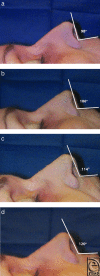Nasal Sculpting: Calculated and Predictable Tip Elevation With Cephalic Trim
- PMID: 26171091
- PMCID: PMC4453984
Nasal Sculpting: Calculated and Predictable Tip Elevation With Cephalic Trim
Abstract
Background: Rhinoplasty techniques to affect nasal tip rotation are well described. Cephalic alar trim is a powerful method for achieving tip elevation. Previous studies and texts provide aesthetic guidelines for nasolabial angles. Often, surgeon experience determines the degree of lower lateral cartilage resection to achieve optimal results. This study analyzes the change in tip elevation with measured resections of the lower lateral cartilages. This can aid the surgeon in accurately predicting the effect of cephalic alar trim on tip elevation.
Methods: Ten fresh cadaveric dissections were performed to determine the change in nasolabial angles after cephalic trim of the lower lateral cartilage. Closed rhinoplasty technique was performed using marginal and intercartilaginous incisions to expose the lower lateral cartilage. Caliper measurements of the lower lateral cartilage were recorded. Serial cephalic trim was performed in 25% increments. True lateral photographs were obtained before and after each serial excision. Nasolabial angle measurements were obtained using a digital goniometer for digital photo analysis.
Results: Four female and 6 male cadavers were evaluated. The mean initial nasolabial angle was 106° ± 2°. The mean lower lateral cartilage width was 9.45 ± 1.38 mm. Serial 25% reductions in lower lateral cartilage height resulted in a mean total nasolabial angle change of 7.4°, 12.9°, and 19.6°, respectively. The mean incremental change in the nasolabial angle was 6.47° ± 1.25°.
Conclusion: The nasolabial angle is an essential aesthetic feature. Cephalic trim is a key maneuver in affecting the nasolabial angle. A 25% lower lateral cartilage cephalic trim correlates with an average change in the nasolabial angle of 6.47°. Knowledge of the cephalic trim to nasolabial angle relationship aids in achieving desired tip elevation.
Keywords: cephalic alar trim; lower lateral cartilage; nasal sculpting rhinoplasty; nasal tip elevation; nasolabial angles.
Figures
References
-
- Staffel JG. Photo documentation in rhinoplasty. Facial Plast Surg. 1997;13:317–32. - PubMed
-
- Gunter JP, Hackney FL. Basic nasal tip surgery. In: Gunter JP, Rohrich RJ, Adams WPJ, editors. Dallas Rhinoplasty: Nasal Surgery by the Masters. St Louis, Mo: Quality Medical Pub; 2007. pp. 303–27.
-
- Beekhuis GJ, Colton JJ. Nasal tip support. Arch Otolaryngol Head Neck Surg. 1986;112:726–8. - PubMed
-
- Rohrich RJ, Huynh B, Muzaffar AR, Adams WP, Robinson JB. Importance of the depressor septi nasi muscle in rhinoplasty: anatomic study and clinical application. Plast Reconstr Surg. 2000;105:376–83. discussion 384-8. - PubMed
-
- Rohrich RJ, Griffin JR. Correction of intrinsic nasal tip asymmetries in primary rhinoplasty. Plast Reconstr Surg. 2003;112:1699–712. discussion 713-5. - PubMed
LinkOut - more resources
Full Text Sources


